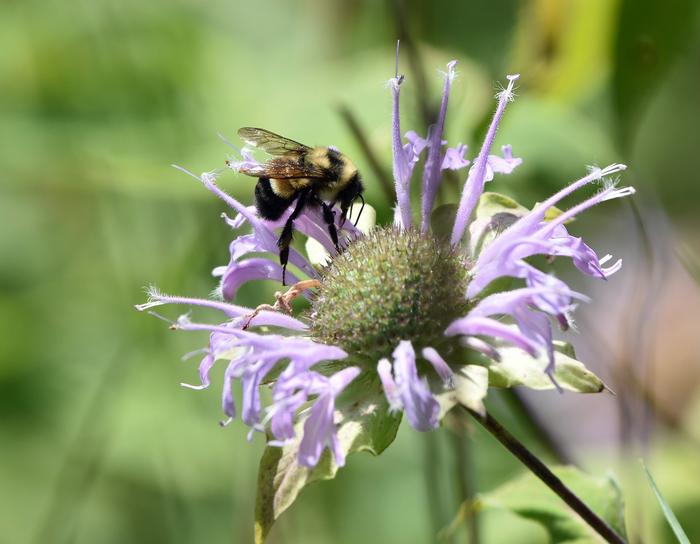A team of researchers has uncovered alarming trends in the first range-wide genetic study of an endangered bee species. The study, led by Colorado State University and published in the Journal of Insect Science, will inform conservation and recovery efforts for the rusty-patched bumblebee – a species that was once common in the United States but has declined from about 90% of its historic range.

Credit: Jay Watson
A team of researchers has uncovered alarming trends in the first range-wide genetic study of an endangered bee species. The study, led by Colorado State University and published in the Journal of Insect Science, will inform conservation and recovery efforts for the rusty-patched bumblebee – a species that was once common in the United States but has declined from about 90% of its historic range.
The rusty-patched bumblebee was the first bee species to be federally listed as endangered in 2017 through the U.S. Endangered Species Act. Its numbers dropped rapidly starting in the late 1990s, likely due to a combination of pesticides, pathogens, habitat loss and degradation, and climate change.
“If that trajectory continues, this species could blink out in the next couple decades,” said lead author John Mola, an ecologist and assistant professor of forest and rangeland stewardship.
The outlook is dire for remaining populations of this important pollinator, according to the in-depth genetic examination by a large team of collaborators, including federal and state agencies, universities, nonprofits and consultants.
Even in strongholds where the bee is still found, scientists observed fewer colonies than a stable species would have and a high rate of inbreeding, which can threaten the long-term viability of a species. Of the bees sampled, 15% showed evidence of inbreeding, through the presence of what are called diploid males. In bees, males are typically haploid and have only one set of chromosomes, but when they’re inbred, they can have two sets of the same chromosomes and lack genetic diversity.
“When that happens, those populations essentially face a death sentence,” Mola said. “They basically have incompatible genetic systems with other populations of the same species.”
Analysis revealed three genetically distinct populations among rusty-patched bumblebees – in the upper Midwest, central Midwest and Appalachians – that will need to be handled differently for potential recovery efforts. Understanding population differentiation is key for captive rearing programs because bees from different populations might not be genetically compatible or might not survive once they’re released into the wild.
“This research is invaluable – it helps us refine healthy colony targets and shows us the importance of optimizing conservation efforts in genetically distinct areas, like the Appalachians,” said co-author Tamara Smith, a wildlife biologist with the U.S. Fish and Wildlife Service.
Protecting pollinators
Pollinators, including bumblebees, are critical for food production and support many other species. Pollinators improve ecosystem health and resilience, and many crops and flowering plants depend on them.
“There are approximately 50 species of bumblebee in North America, but there are big differences between bumblebees in the same way that there are big differences between songbirds and hawks,” Mola said. “They’re not substitutable.”
Decline of the rusty-patched bumblebee could be a harbinger of die-offs of other species that were once common.
“Unfortunately, we’re looking at a future scenario where about one in five bumblebee species in the United States could be endangered,” Mola continued.
But there is hope.
The rusty-patched bumblebee’s endangered listing has led to programs that restore habitat and the bee’s preferred plants. Pollinator-friendly home and community gardens make a difference, too, Mola said.
“At times, there can be doom and gloom in conservation, but there are good examples of butterfly species that have been recovered through careful conservation planning,” he added. “The same thing applies with bumblebees.”
Additionally, restoration projects that benefit bumblebees benefit other wildlife and landscape health in general.
Project partners, process
Surveying the rusty-patched bumblebee across its entire U.S. range required a vast network of collaborators with proper permits to collect genetic samples from the endangered species. Sampling involved catching the bees in nets, briefly putting them on ice and clipping off a tiny bit of leg – enough to conduct the study but not so much that it would interfere with their ability to function.
“Numerous partners recognized the importance of collecting these data, and we thank them for their contributions,” Smith said.
The project was mostly funded by the U.S. Geological Survey Science Support Partnership and the Great Lakes Restoration Initiative’s Threatened and Endangered Species Template through the U.S. Fish and Wildlife Service. The study was led by authors Mola, Smith, Ian Pearse (USGS), Michelle Boone (University of Minnesota), Elaine Evans (University of Minnesota), Mark Hepner (Metamorphic Ecological Research and Consulting), Robert Jean (Environmental Solutions and Innovations), Jade Kochanski (University of Wisconsin–Madison), Cale Nordmeyer (Minnesota Zoo), Erik Runquist (Minnesota Zoo), James Strange (Ohio State University), Jay Watson (Wisconsin Department of Natural Resources) and Jonathan Koch (U.S. Department of Agriculture).
Journal
Journal of Insect Science
Method of Research
Observational study
Subject of Research
Animals
Article Title
Range-wide genetic analysis of an endangered bumble bee (Bombus affinis, Hymenoptera: Apidae) reveals population structure, isolation by distance, and low colony abundance
Article Publication Date
3-Apr-2024



